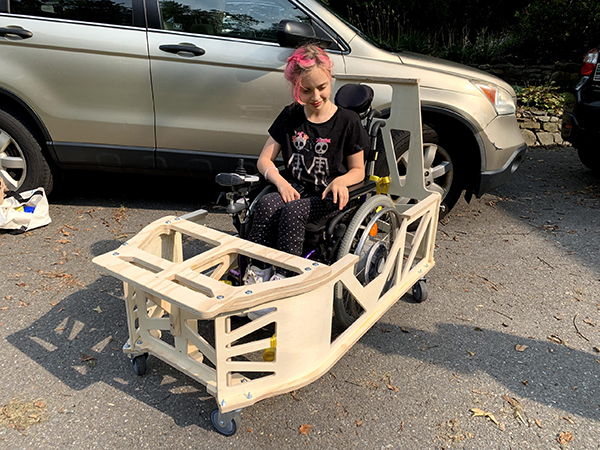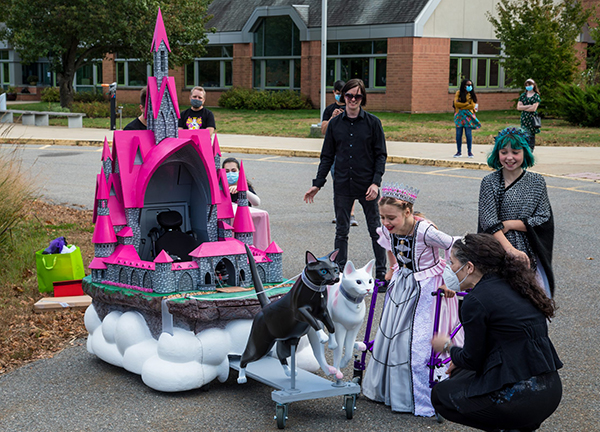
Volunteers from SolidWorks and Magic Wheelchair came together to build a castle-carriage for Freyja Christian. Image courtesy of SolidWorks
How to Build a Castle-Carriage for a Princess in the Middle of a Pandemic
Wheelchair maker and CAD software developer joined forces to create princess-themed castle and carriage wheelchair
Latest News
November 5, 2021
Ten-year-old Freyja Christian uses a wheelchair to get around. She also uses her imagination to travel in the realms of fairy tales. In her letter to the Magic Wheelchair, a nonprofit that builds costumes for children in wheelchairs, she specifically requested “a princess castle or a carriage ... flying mermaids, cats, and dragonflies.”
When Freyja was less than one year, she was diagnosed with pontocerebellar hypoplasia, a rare neurological disorder that hinders brain development. For her, the wheelchair is independence.
For Annie Cheung, Senior Manager, Product Definition, SolidWorks, Magic Wheelchair is a vehicle for creativity. She and a team of volunteers at SolidWorks have worked on previous projects for the organization. Freyja's wheelchair would become the team's third build.

A Castle for Princess Freyja
Previous collaboration between SolidWorks user community members and Magic Wheelchair resulted in a series of custom wheelchairs designed to fit the characters and personalities of a select group of children. They included a movable throne, inspired by the “Be our guest” song from Beauty and the Beast; and a Star Wars-themed wheelchair, inspired by the Star Wars Mandalorian.
During the pandemic, the team went to work on Freyja's castle-carriage-wheelchair, drawn by a pair of fantastic beasts. The team used 3DSwym, a social media-style collaboration platform by Dassault Systemes. Here, concept sketches slowly began to take shape.
The primary 3D modeling was done in SOLIDWORKS CAD. “We used SOLIDWORKS CAD to generate the G-code that was needed for machining the different pieces. A lot of the elements for the costume came to life because we had the G-code,” Annie said in the YouTube SOLIDWORKS Live event.
For the army of winged fairies and dragonflies, the team 3D printed them and magnetically mounted them, with embedded RFID tags and lights to turn them on and off as desired. “We needed to use SLA printing, which can capture a lot of the smaller details,” said Annie.
The dragonflies were modeled from scratch in xShape, a 3D sculpting program. “You basically start with a digital piece of clay, then push and pull it,” recounted Jordan Tadic, Senior Solution Consultant, SolidWorks.

3D-Printed Castle Carriers
Perhaps the most prominent features of Freyja's carriage are the two giant cats drawing it. Those two giants (each about one-third the size of Freyja herself) were also modeled in xShape by Rob Jost, Senior Manager, Product Definition, SolidWorks. “The subdivision command really helped me, especially around the eyes,” he said.
The creatures were much too big to fit into a 3D printer's typical print chamber, so they were printed as separate pieces. “I counted them. There were 53 different body parts for the cats,” verified Jost.
The carriage was unveiled to Freyja and her family during her tenth birthday, in front of her party guests. She named her carriage-drawing cats Annie and Christine.
For an interview with the SolidWorks team and Freyja, see the video below.
More Dassault Systemes Coverage

Subscribe to our FREE magazine, FREE email newsletters or both!
Latest News
About the Author
Kenneth Wong is Digital Engineering’s resident blogger and senior editor. Email him at [email protected] or share your thoughts on this article at digitaleng.news/facebook.
Follow DE






